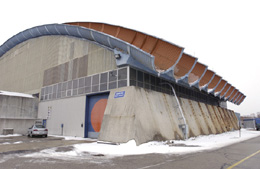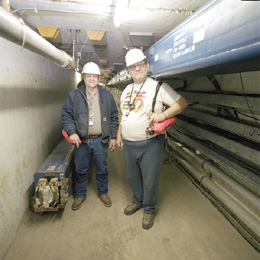 |
|
Science Returns to Meson Lab by Kurt Riesselmann
It seems like the best of places and the worst of places. Built 30 years ago, the Meson Laboratory is one of the architectural landmarks on the Fermilab site. Covering half the size of a football field, the building features a scallop- like roof created from half-sections of steel culverts.Visitors can easily spot this eye-catching structure,painted bright blue and orange. Scientists have learned to cope with another feature of the industrial-type building: leaks. From its very beginning the fancy steel roof has been less than perfect at keeping rain out. Numerous attempts to seal the roof have failed,and scientists have learned to protect sensitive equipment by erecting waterproof enclosures within the building’s vast interior. The Meson Lab has hosted more than 130 experiments. Until 1999, operators could send beams of protons from Fermilab’s most powerful accelerator through a 1.5-mile underground beam line to the Meson Lab, directing the protons to six different experimental areas within the building. The Main Ring started out with 200 GeV protons in 1972. Upgrades allowed scientists to use 400 GeV protons only three years later.The advent of the Tevatron accelerator in 1983 enabled physicists to direct 800 GeV protons onto targets at the Meson Lab. Physicists sifted through the resulting debris using many different types of detectors, discovering and studying the fundamental building blocks of matter. In particular,scientists produced and analyzed mesons, particles composed of a quark and an antiquark. Hence the building’s name. In the last couple of years it’s been pretty quiet in and around the Meson Lab. The last experiments took place a few years ago. Since then, visitors to the building stood a better chance of meeting a raccoon than a scientist.
SCIENTISTS RETURN “It’s the final step to take full advantage of the Main Injector’s capabilities,” said Erik Ramberg, who managed the revival of the Meson Lab.“The Main Injector is going to fulfill its promise of supporting a fixed-target program.” Every three seconds, the Main Injector can deliver beam to the Meson Lab. Right before the particles reach the lab, scientists can direct the protons to different experimental areas. Placing various types of material,or targets, in the proton beam’s path, experimenters can customize the beam by creating mesons such as pions and kaons. One experimental area is the Meson Test Beam Facility. It will provide users with the infrastructure to conduct tests of detector prototypes. Ramberg, who heads the MTBF, knows what users want: particle identification system, gas delivery system, and data acquisition system. They all exist at MTBF. “There are not many of these test beam facilities around,” Ramberg said.“Ours is pretty fancy. Compared to the past,we now offer more support from the lab, better infrastructure and more versatility with regard to the test beam.”
DÉJÀ VU “I joined the lab in 1974,” said Chuck Brown, who has managed the new installation.“One of my first projects was to help upgrade the beam line to the Meson Lab from 200 to 400 GeV.Now we have reinstalled some of the same magnets that were used then —after they ’ve undergone renovation and testing by the Technical Division.” Brown took over the project a year ago after the death of Thornton Murphy,who had led the project for about one year. “It was a big challenge to renovate and install all this old equipment,” Brown said.“Instrumentation, power supplies,electronics all needed to be renovated and updated.Yet we had very little manpower since Run II takes precedence.” After a decade of little or no increases in the Fermilab budget, projects not directly related to Collider Run II of the Tevatron accelerator have received low priority. Scientists had hoped to get beam to the Meson Lab in summer of 2002, but Paul Feyereisen and other technicians involved in the beam line upgrade were often needed in projects related to Run II. Now MTBF is almost operational.A second experimental area, dedicated to the Main Injector Particle Production (MIPP) experiment,might be ready before the end of the year.A third beam delivery area, intended for the Charged Kaons at the Main Injector (CKM) experiment,will be added in the future.
EXPERIMENTERS READY TO GO “We’ll use the 120 GeV protons to check the simulations that we developed for our detector,” said KU Professor Alice Bean of the Radio Ice Cerenkov Experiment.“We have this new detection method that uses radio antennas to identify particles passing through a transparent medium. The electric field emitted by fast,charged particles is like a pancake.That ’s what we are looking for.” In 1999, RICE experimenters deployed a first set of 16 radio receivers at a depth of 300 to 700 feet near the South Pole to study cosmic particles. Ideally,the foot-long antennas can pick up electromagnetic signals from particles traveling through the ice as far away as one kilometer. At Fermilab,the group will study the technique in more detail,embedding inch-long antennas in large tubes filled with wax rather than ice. The BTeV group,which prepares for a large-scale experiment to take place several years from now, is analyzing the performance of its pixel detectors. The sensors consist of tiny rectangles of silicon that create electric signals when hit by charged particles.To record the signals,Fermilab engineers have designed chips that amplify and digitize the electric pulses.The chips then transmit the digital data to a data acquisition system. “The data acquisition cards plug directly into PCs,” said Fermilab engineer Brad Hall,who worked on the new system design.“We built the DAQ from ground up.We have designed a system that is more cost effective and flexible than in previous test systems,yet it still has the performance we need.” At the Meson Test Beam Facility, BTeV experi- menters will test the new DAQ system under field conditions.In addition,physicists will analyze the performance of the pixel sensors after long-term exposure to showers of particles.Since the full- scale BTeV experiment will collect data for several years,the reliability of all detector subsystems is of great importance.Three other BTeV subgroups have submitted proposals to test different detector components at the Meson Lab as well. Ramberg is quite excited about the future of the test facility.He toured similar facilities at other laboratories before drawing plans for a revived Meson Lab.Now,with first beam about a month away,he is convinced of the prospects. “I have used three other test beam facilities in the past,and can thus appreciate the need for them,” he said.“The user community will absolutely love this one.”
ON THE WEB:
|


